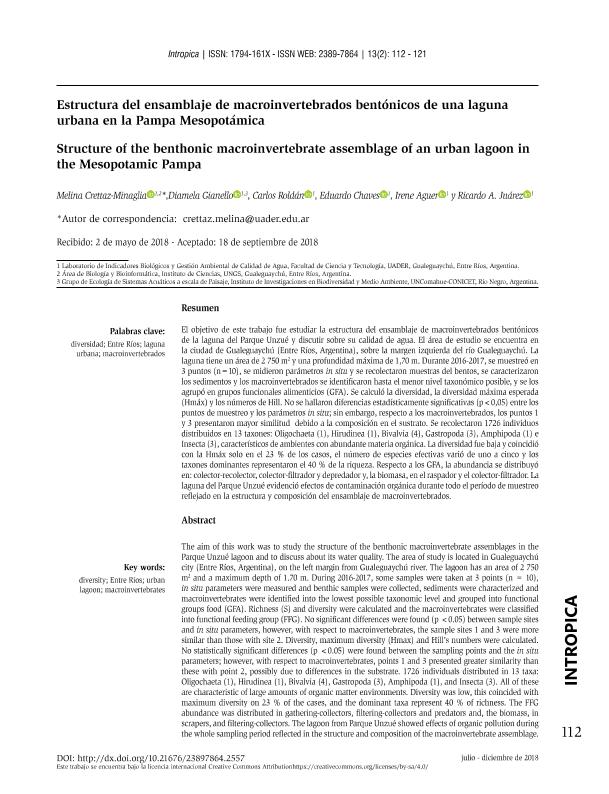Artículo
El objetivo de este trabajo fue estudiar la estructura del ensamblaje de macroinvertebrados bentónicos de la laguna del Parque Unzuéy discutir sobre su calidad de agua. El área de estudio se encuentra en la ciudad de Gualeguaychú (Entre Ríos, Argentina), sobre la margen izquierda del río homónimo. La laguna tiene un área de 2750 m2y una profundidad máxima de 1,70 m. Durante 2016-2017, se muestreó en 3 puntos (n=10), se midieron parámetros in situ y se recolectaron muestras de bentos, se caracterizaron los sedimentos y los macroinvertebrados fueron identificados hasta el menor niveltaxonómico posible y se los agrupó en grupos funcionales alimenticios (GFA). Se calculó la diversidad, ladiversidad máxima esperada (Hmáx) y los números de Hill. No se hallaron diferencias estadísticamente significativas (p<0,05) entre los puntos de muestreo y los parámetros in situ; sin embargo, respecto a los macroinvertebrados, los puntos 1 y 3 presentaron mayor similitud que estos con el punto 2, posiblemente debido a las diferencias en el sustrato. Se colectaron 1726 individuos distribuidos en 13 taxones: Oligochaeta (1), Hirudinea (1), Bivalvia (4), Gastropoda (3), Amphipoda (1) e Insecta (3), los cuales son característicos de ambientes con abundante materia orgánica. La diversidad fue baja y coincidió con la Hmáx solo en el 23% de los casos, el número de especies efectivas varió de 1-5 y los taxones dominantes representaron el 40% de la riqueza. Respecto a los GFA, la abundancia se distribuyó en: colector-recolector, colector-filtrador y depredador y, la biomasa, en raspador y colector-filtrador. La laguna del Parque Unzué evidenció efectos de contaminación orgánica durante todo el período de muestreo reflejado en la estructura y composición del ensamblaje de macroinvertebrados. The aim of this work was to study the structure of the benthonic macroinvertebrate assemblages in the Parque Unzué lagoon and to discuss about its water quality. The area of study is located in Gualeguaychú city (Entre Ríos, Argentina), on the left margin from Gualeguaychú river. The lagoon has an area of 2 750 m2 and a maximum depth of 1.70 m. During 2016-2017, some samples were taken at 3 points (n = 10), in situ parameters were measured and benthic samples were collected, sediments were characterized and macroinvertebrates were identified into the lowest possible taxonomic level and grouped into functional groups food (GFA). Richness (S) and diversity were calculated and the macroinvertebrates were classified into functional feeding group (FFG). No significant differences were found (p <0.05) between sample sites and in situ parameters, however, with respect to macroinvertebrates, the sample sites 1 and 3 were more similar than those with site 2. Diversity, maximum diversity (Hmax) and Hill’s numbers were calculated. No statistically significant differences (p <0.05) were found between the sampling points and the in situparameters; however, with respect to macroinvertebrates, points 1 and 3 presented greater similarity than these with point 2, possibly due to differences in the substrate. 1726 individuals distributed in 13 taxa: Oligochaeta (1), Hirudinea (1), Bivalvia (4), Gastropoda (3), Amphipoda (1), and Insecta (3). All of these are characteristic of large amounts of organic matter environments. Diversity was low, this coincided with maximum diversity on 23 % of the cases, and the dominant taxa represent 40 % of richness. The FFG abundance was distributed in gathering-collectors, filtering-collectors and predators and, the biomass, in scrapers, and filtering-collectors. The lagoon from Parque Unzué showed effects of organic pollution during the whole sampling period reflected in the structure and composition of the macroinvertebrate assemblage.
Estructura del ensamblaje de macroinvertebrados bentónicos de una laguna urbana de la Pampa Mesopotámica
Título:
Structure of the benthonic macroinvertebrate assemblage of an urban lagoon in the Mesopotamic Pampa
Crettaz Minaglia, Melina Celeste ; Gianello, Diamela
; Gianello, Diamela ; Roldan, Carlos Alberto
; Roldan, Carlos Alberto ; Chaves, Eduardo Alberto; Aguer, Irene; Juárez, Ricardo Ariel
; Chaves, Eduardo Alberto; Aguer, Irene; Juárez, Ricardo Ariel
 ; Gianello, Diamela
; Gianello, Diamela ; Roldan, Carlos Alberto
; Roldan, Carlos Alberto ; Chaves, Eduardo Alberto; Aguer, Irene; Juárez, Ricardo Ariel
; Chaves, Eduardo Alberto; Aguer, Irene; Juárez, Ricardo Ariel
Fecha de publicación:
11/2018
Editorial:
Universidad de Magdalena
Revista:
Intropica
ISSN:
1974-161X
e-ISSN:
2389-7864
Idioma:
Español
Tipo de recurso:
Artículo publicado
Clasificación temática:
Resumen
Palabras clave:
DIVERSIDAD
,
ENTRE RÍOS
,
LAGUNA URBANA
,
MACROINVERTEBRADOS
Archivos asociados
Licencia
Identificadores
Colecciones
Articulos(INIBIOMA)
Articulos de INST. DE INVEST.EN BIODIVERSIDAD Y MEDIOAMBIENTE
Articulos de INST. DE INVEST.EN BIODIVERSIDAD Y MEDIOAMBIENTE
Articulos(SEDE CENTRAL)
Articulos de SEDE CENTRAL
Articulos de SEDE CENTRAL
Citación
Crettaz Minaglia, Melina Celeste; Gianello, Diamela; Roldan, Carlos Alberto; Chaves, Eduardo Alberto; Aguer, Irene; et al.; Estructura del ensamblaje de macroinvertebrados bentónicos de una laguna urbana de la Pampa Mesopotámica; Universidad de Magdalena; Intropica; 13; 2; 11-2018; 112-121
Compartir
Altmétricas



